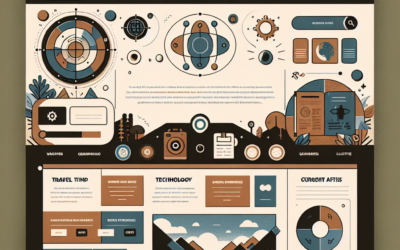Discover The Importance of a Clean Website Design for enhancing user experience, boosting SEO, and increasing conversions in today’s digital landscape.
Mastering Visual Hierarchy in Web Design: The Ultimate Guide to Create Engaging Websites and Improve User Experience
In the realm of web design, visual hierarchy is a crucial principle that guides how users perceive information on a webpage. It refers to the arrangement and presentation of visual elements to indicate their importance, making it easier for users to navigate your site. By implementing effective visual hierarchy, designers can lead the viewer’s eye to vital information and ensure a seamless user experience.
The fundamental elements of visual hierarchy include size, color, contrast, and spacing. For instance, larger fonts generally command more attention than smaller ones, making headlines a primary focus. Similarly, colors can evoke emotions and direct attention. Utilizing contrasting colors for call-to-action buttons helps them stand out against the background, compelling users to engage. Incorporating the right color theory in web design can significantly enhance your site’s appeal and usability; to explore more about this, check out this beginner’s guide on color theory.
Whitespace, often overlooked, plays an essential role in the effective presentation of content. It helps to organize elements on a page, preventing clutter and confusion. Strategic spacing between text blocks and images allows users to breathe while they absorb information. This “breathing room” guides users smoothly through the content, enhancing readability and interaction. A minimalist approach to web design can often lead to better user engagement, and you can learn more about it in our article on minimalist web design principles.
Additionally, incorporating typography into your visual hierarchy cannot be understated. Different fonts can convey different meanings, and a strategic combination can create an engaging reading experience. Use font weights and styles purposefully to differentiate between headings, subheadings, and body text. This method will not only improve legibility but also guide users through the hierarchy of information effectively.
Ultimately, mastering visual hierarchy in web design involves the thoughtful orchestration of various elements to create a coherent and engaging user experience. By focusing on these principles, designers can elevate their websites, capturing attention and guiding users seamlessly through the intended journey. For in-depth strategies on implementing visual hierarchy effectively, reference our guide on creating visual hierarchy within your web designs.
How to Build Trust and Credibility Through Website Design
Learn how to Build Trust and Credibility Through Website Design with user-friendly elements, responsive layouts, and effective SEO strategies for business growt
The Role of User Experience in SEO – Search Engine Optimization
Discover how The Role of User Experience in SEO impacts search rankings and boosts engagement, conversions, and brand perception. Optimize your site today!
Creating Visual Hierarchy in Web Design
Enhance your website’s effectiveness with Visual Hierarchy in Web Design. Discover key principles, best practices, and emerging trends for optimal user experien
UX Design Tips – Boost Your Website’s User Experience
Discover essential UX Design Tips to enhance your website’s user experience, boost engagement, and keep visitors coming back for more!



